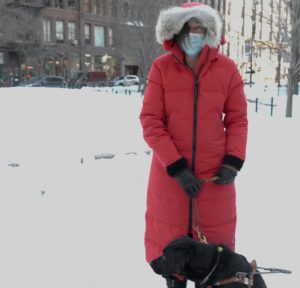Snow and Ice: It’s an Accessibility Issue
by Beth

Beth and Seeing Eye Dog Luna posing in a snowy park; Beth in a long red winter coat and a face mask.
Every winter here in Chicago, I find myself questioning why it is that when snow plows clear passage for cars, the snow mounds they leave on curb cuts and crosswalks go unshoveled. What about the pedestrians? This article in Forbes says it well:
Plowing equipment exists that can clear sidewalks at least as efficiently as streets are cleared by conventional plows. College campuses and companies with large and complex facilities use them. But very few cities take full responsibility for clearing sidewalks the way they all do for clearing streets. And by and large, either taxpayers don’t want to fund it, or politicians don’t want to risk asking. So while some winter weather cities and towns are better than others for winter accessibility, very few do a genuinely good job of it.
Temperatures are hitting record lows (and are staying there) in many parts of the country this week. With so many people working or attending school classes from home due to COVID-19 regulations this winter, many Americans are spending less time in their cars and more time walking outside. Traveling on snowy icy sidewalks to take short breaks from work, run errands, help neighbors, or just get exercise can be difficult. And if you use a wheelchair, it is often impossible.
We appreciate city services plowing the streets, but if they don’t clear the crosswalks, curb cuts and sidewalks , how can pedestrians get safely across to the other side? In addition to people with certain disabilities, other parts of the U.S. population do not drive, including:
- Children
- Many people age 65 or better
- Those who cannot afford a personal vehicle
- A growing number of people who simply choose not to drive.
Sidewalks and crosswalks are necessary for all of us who don’t drive. More from that Forbes article:
If this was purely a weather problem, then disabled people would have no choice but to endure, or somehow find a way to move to warmer climates. But winter weather accessibility barriers are also a policy and practice problem. Winter weather would be substantially less of a problem if cities and towns made it a higher priority.
Maybe we, pedestrians, all need to band together? In the meantime, those of us stuck at home in the aftermath of a snowstorm might want to use our time inside to check out our winter safety tips for people with disabilities.
Happy reading, and hang in there — it’s all gotta melt sometime.






